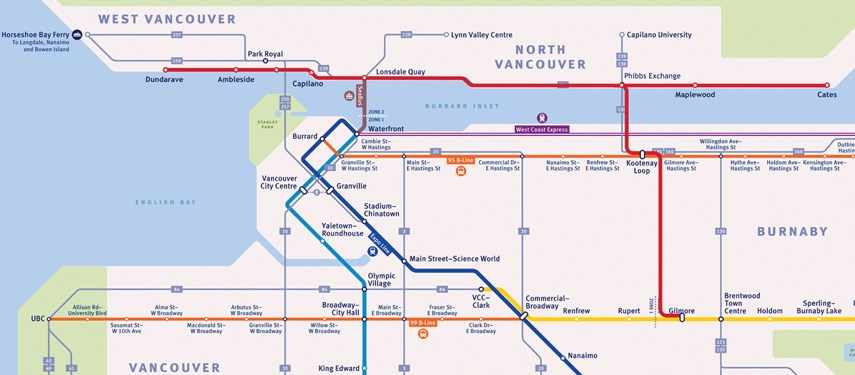If you’re patiently waiting for the SkyTrain to arrive on the North Shore, you could be in for a long wait.
Mayor Darrell Mussatto began raising this issue publicly this spring, calling for a feasibility study. And North Vancouver-Seymour Liberal MLA Jane Thornthwaite broached the topic in the legislature twice in the last session.
But TransLink CEO Kevin Desmond has responded saying the transit authority is too focused on expanding the existing system to be getting serious about new megaprojects.
“I think the recent conversations, particularly about SkyTrain coming to the North Shore are just indicative of the thirst people have to improve the transportation infrastructure and the transit system,” he said during a recent visit to North Vancouver. “We need to start advancing the current 10-year plan, moving forward with that with the support of the new provincial government to help make that happen. Then we have to move on and think about what the next plan is and the next plan after that,” he said.
If a fixed rail bridge or tunnel to Vancouver is a high priority for residents, they should make that known in the upcoming review TransLink is doing of its 30-year regional transportation strategy, Desmond said.
But Thornthwaite isn’t waiting 30 years. She’s already drawn up a proposal including hypothetical transit map featuring a SkyTrain connection over the Second Narrows with stops across the North Shore, from Cates Park to Dundarave. And she’s started consulting with local MPs and the North Vancouver Chamber of Commerce.
“I desperately want to have the idea of a SkyTrain to the North Shore on the map of the mayors’ council,” she said. “I’m talking about a bold vision here. I think we all have to start having these conversations.”
Thornthwaite said she was inspired to lobby for a North Shore rail link because constituents in North Vancouver-Seymour have very little coming to them in terms of transit improvements.
“If we want to have any hope of encouraging and incentivizing our people to get out of their cars and take transit, we’ve got to start improving the system,” she said. “I would certainly like TransLink to consider the option of SkyTrain to the North Shore within their 10-year (transportation) plan. Right now, there’s nothing in my riding from the (mayors’) 10-year plan and there’s hardly anything for the North Shore.”
Funding is in place currently for a new SeaBus, which will allow 10-minute service during rush hour, a 30 per cent increase in regular bus service and new B-Line buses for the North Shore.
Thornthwaite said she hasn’t done any back-of-the-envelope calculations on what such a plan would cost although she conceded it would be in the billions.
“But the only way we can get an assessment going and the interest from the decision-makers like TransLink and the mayors’ council is to start talking about it. That’s what I’m trying to do. Everybody I’ve talked to thinks it’s a good idea.”
Such a rail line could even be connected to Squamish and Whistler over the longer term, Thornthwaite added.
Gordon Price, fellow with SFU’s Centre for Dialogue and former head of the university’s city program, said it’s refreshing to see the discussion of a fabled “third crossing” return but centred around mass transit for a change.
“It’s certainly doable and it could certainly be doable faster than what dreamers might think at this point. That’s a political and financial commitment,” he said.
But before North Vancouver and West Vancouver can pursue a rail link with any seriousness, they have to be able to answer some existential questions about the kind of communities they aspire to be. To justify a SkyTrain, our urban planning would have to become much more centred around transit over the long term than it currently is.
“If you’re going to be looking at something like SkyTrain rapid transit, and you should, it’s a long-term solution. We’re talking over 100 years. And it means a fundamental change in the scale, and for some parts of your community, a fundamental change in character. You’re building transit-oriented, concentrated communities with both work and play and all the rest of it,” he said. “Because otherwise, why build rapid transit?”
Park Royal would have to look more like Burnaby’s Brentwood neighbourhood, Price used as an example.
“North Van and West Vancouver would have to commit themselves to having a different kind of long-term vision for themselves, and I’m not sure that the population is yet ready for that,” he said.
But, Price noted, if the hope is that a North Shore SkyTrain would be the silver bullet to solving the bridge congestion problem, there are much cheaper and faster options within reach, namely mobility pricing. The technology to track usage of the roads and transit system in real time exists in most anyone’s smartphone, meaning it would not be difficult to charge tolls based on usage. That would be the most effective incentive for getting people and cars off the road, and speeding up the daily commutes, Price said.
“That’s going to be so much easier to do in the world we’re moving into. We’re not quite there yet but it’s happening,” he said. “The politics of that? Brutal. But it could be done.”



